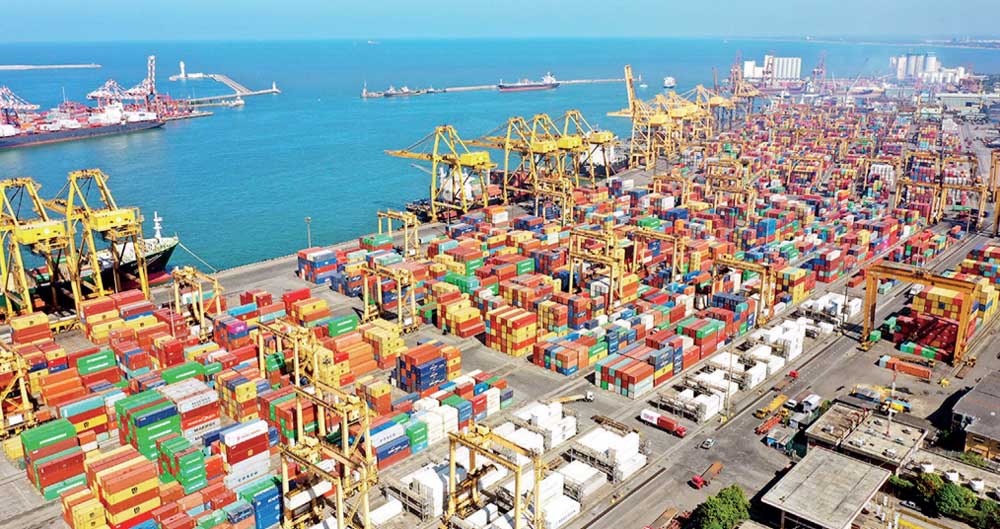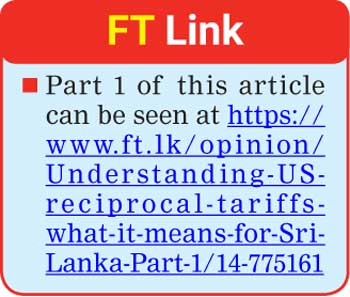Monday Apr 28, 2025
Monday Apr 28, 2025
Saturday, 5 April 2025 00:05 - - {{hitsCtrl.values.hits}}

The pathway ahead will require sustained policy momentum, strategic alliances, and pragmatic reforms
 Introduction
Introduction
With the enactment of the US Executive Order on Reciprocal Tariffs—unveiled on 2 April 2025—Sri Lanka finds itself among the nations most heavily impacted, facing a 44% ad valorem duty on all goods exported to the US. The first part of this article series provided a comprehensive breakdown of the origin, rationale, and structure of this policy. It examined how countries were tiered and how Sri Lanka’s effective trade burden was assessed at 88%, culminating in its current tariff status.
Part 2 shifts focus from the cause and effect to the course of action. It evaluates the steps Sri Lanka can take to mitigate the economic fallout, adjust its trade orientation, and leverage this moment as a turning point for reform. Encouragingly, the Sri Lankan Government has already initiated concrete and timely action. These include launching diplomatic engagements and appointing a high-level committee to assess and respond to the challenge. While the situation is serious, it is far from insurmountable.
This article outlines short-term, medium-term, and long-term strategies for Sri Lanka and identifies opportunities for recalibration and resilience. The tone is intentionally constructive—because the present disruption, if managed skilfully, can also become a catalyst for transformation.
1.Immediate response: Structured engagement and policy alignment
 In response to the US Executive Order, the Sri Lankan Government acted promptly by initiating a coordinated national response.
In response to the US Executive Order, the Sri Lankan Government acted promptly by initiating a coordinated national response.
On 3 April 2025, President Anura Kumara Disanayake appointed a high-level expert committee tasked with assessing the implications of the reciprocal tariffs and advising on mitigation strategies. This committee includes senior officials from key economic institutions such as the Ministry of Finance, Central Bank, BOI, EDB, and Foreign Ministry, alongside representatives from the private sector and academia. Its scope covers a full-sectoral impact assessment and the formulation of a national action plan.
The Deputy Minister of Economic Development further clarified that the tariff was not a targeted action against Sri Lanka but part of a broader recalibration of US trade policy. In this context, the government has begun diplomatic engagements, including outreach to the US Trade Representative’s office, to advocate for Sri Lanka’s case, particularly in light of its IMF-backed reforms and developing country status.
The committee’s role is especially critical. It is well-positioned to assess and integrate many of the strategies discussed in this article—from trade diversification and tariff engineering to proactive WTO diplomacy and value chain strengthening. The Government’s willingness to act swiftly and seek expert input reflects the importance of aligning policy, diplomacy, and industry support in facing the reciprocal tariff regime.
2.Reframing the challenge
Before delving into long-term strategies, it is important to reframe the situation not as an insurmountable threat but as a disruption that can be managed through smart, data-driven policies.
It is crucial to note:
3.Strategic pathways for Sri Lanka
Sri Lanka’s response should be mapped over three time horizons—short, medium, and long term—each with specific policy levers and institutional actions.
A.Short-term (0–6 months): Stabilise and signal
Objective: Maintain business confidence, prevent export disruption, and open diplomatic channels.
Key actions:
1.High-level diplomacy
2.Communicate transparently with exporters
3.Conduct a sectoral impact assessment
4.Build multilateral coalitions
5.Safeguard forex flows
B.Medium-term (6–24 months): Diversify and upgrade
Objective: Reduce vulnerability to US demand shocks by diversifying export destinations, upgrading value chains, and improving trade architecture.
Key strategies:
1.Market diversification
2.Export value addition
3.Investor confidence measures
4.Improve trade facilitation and compliance
5.Negotiate for inclusion in exclusion lists
C.Long-Term (2–5 years): Restructure and resilience
Objective: Future-proof Sri Lanka’s export economy through institutional reform and systemic repositioning.
Key policy pathways:
1.Trade policy modernisation
2.Manufacturing ecosystem strengthening
3.WTO engagement and legal recourse
4.Green and ethical trade leadership
5.Export resilience planning
4.Sector-specific priorities
Sri Lanka’s response must recognise the asymmetric exposure across sectors:
Apparel
Rubber and industrial goods
Agriculture and plantation
Logistics and shipping
Develop warehousing and re-export models to segment high-tariff destinations.
Promote Colombo Port’s role in transshipment over direct-to-US models.
5.A coordinated national effort
Sri Lanka’s ability to adapt will hinge on whole-of-government and whole-of-society coordination.
The expert committee appointed by the President represents a critical institutional response. Its composition reflects broad stakeholder engagement, and its mission aligns with many of the actions outlined in this article. Follow-through will be essential, and the committee’s recommendations must translate into coherent policy, legislative action, and diplomatic communication.
6.A new model of engagement with the US
Beyond immediate remedies, Sri Lanka must begin crafting a new model of engagement with the United States.
This includes:
Conclusion: From retaliation to reinvention
Sri Lanka is at a crossroads. The 44% US tariff is not just a numerical penalty—it is a test of institutional maturity, policy agility, and economic imagination.
To its credit, the Government has moved quickly, launching diplomatic outreach and appointing an expert task force. These are foundational steps. The pathway ahead will require sustained policy momentum, strategic alliances, and pragmatic reforms.
As the global trade architecture becomes more contested, small but nimble nations like Sri Lanka must lead with clarity, courage, and coordination. The reciprocal tariffs, harsh though they are, may yet become the trigger for a long-overdue transformation.
Further analysis is available in the full policy brief “US Reciprocal Tariffs: Impact on Sri Lanka” [https://tinyurl.com/nhk258xm]
(The writer is a Chevening Fellow from St. Cross College – University of Oxford and a trade policy enthusiast.)
Discover Kapruka, the leading online shopping platform in Sri Lanka, where you can conveniently send Gifts and Flowers to your loved ones for any event including Valentine ’s Day. Explore a wide range of popular Shopping Categories on Kapruka, including Toys, Groceries, Electronics, Birthday Cakes, Fruits, Chocolates, Flower Bouquets, Clothing, Watches, Lingerie, Gift Sets and Jewellery. Also if you’re interested in selling with Kapruka, Partner Central by Kapruka is the best solution to start with. Moreover, through Kapruka Global Shop, you can also enjoy the convenience of purchasing products from renowned platforms like Amazon and eBay and have them delivered to Sri Lanka.
Discover Kapruka, the leading online shopping platform in Sri Lanka, where you can conveniently send Gifts and Flowers to your loved ones for any event including Valentine ’s Day. Explore a wide range of popular Shopping Categories on Kapruka, including Toys, Groceries, Electronics, Birthday Cakes, Fruits, Chocolates, Flower Bouquets, Clothing, Watches, Lingerie, Gift Sets and Jewellery. Also if you’re interested in selling with Kapruka, Partner Central by Kapruka is the best solution to start with. Moreover, through Kapruka Global Shop, you can also enjoy the convenience of purchasing products from renowned platforms like Amazon and eBay and have them delivered to Sri Lanka.